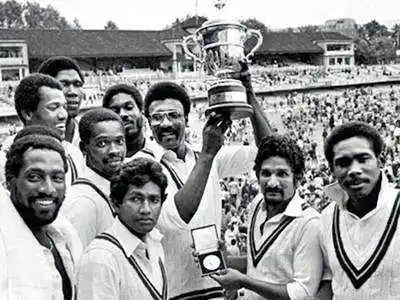The First Hands on the Cup
West Indies and Australia met on a June morning to play the first World Cup final ever, unaware that they were playing a fixture that would become the biggest game of the cricketing calendar in a few years.

Clive Lloyd holds aloft the World Cup trophy. Credits- Mumbai Mirror
More than 48 years ago, in the summer of 1975, the first-ever cricket World Cup was organised to test the waters. This was a time when cricket was becoming a more global sport that had been dominated by England and Australia until the 60s. Then rose the mythical West Indies team, with swashbuckling batsmen and the most feared pacers on the planet, who could make the ball swing and bounce on command as if it was being controlled with a remote, all at a blistering pace of over 140.
Although West Indies had become the toughest and most intimidating place to tour, the English-Australian rivalry still received the topmost billing, and England was still the metaphorical mecca of cricket. It was a no-brainer, then, to host the first-ever World Cup in England, despite concerns that rain might play spoilsport through June.
At that time, one-day internationals as a format was still in its early days—test cricket was the zenith of the game and ODIs were merely an afterthought. Funnily enough, the first ODI ever was an unplanned accident. To compensate for an Ashes test match in Melbourne ruined by rain, the organizers thought of giving the audience their money's worth and thus the first ODI was played. Much like shorter formats today, there was a disdain for it amongst cricket purists, for cricket had been a traditional game that hadn't seen a lot of changes up until now.
Test matches for a World Cup weren't feasible at all—first, each game took four to five days to end and players just weren't ready to play so many games in a round-robin tournament with knockout stages in the space of a month. The organisers did not have high hopes—there were fears that rain would not be kind to the tournament, especially after a month of relentless downpours in May. To be on the safe side of things, an Ashes series guaranteed to rake in revenue was scheduled right after the tournament would end so that any losses incurred could be recouped.
To everyone's surprise, crowds were drawn to these matches like a moth to flame. The sheer number of quality players made the contests appealing to people and the tag of World Champions seemed to increase the stakes significantly. Four teams proceeded to qualify for the semi-finals: Australia was to play England and New Zealand was up against the West Indies.
An Ashes game repackaged as a World Cup semi-final was always going to be a hit, and how close the contest actually turned out to be helped cement the tournament as a classic. The final, played between Australia and West Indies, went on till 9 in the night, but everyone stuck around to witness the West Indies make cricketing history.
Although the Windies are a shadow of the cricketing powerhouse they used to be, with players like Clive Lloyd, Viv Richards, Keith Boyce, Andy Roberts, and Vanburn Holder, they will forever remain immortalised as the first-ever World Champions (and the second too, they defended their crown four years later, this time by defeating the English). Today, the Cricket World Cup is the biggest festival in cricket, a far cry from its humble beginnings in 1975.


